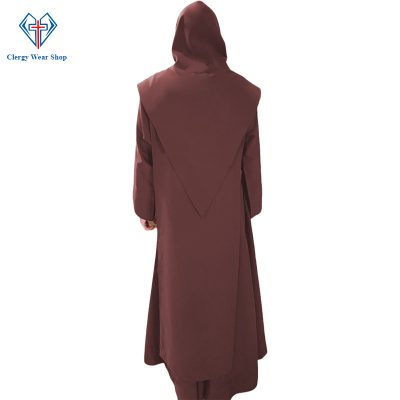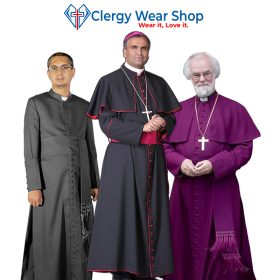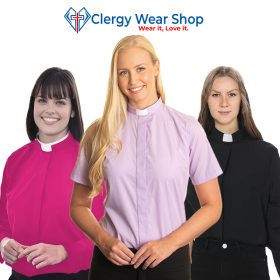Clergy Robes for Men
Exploring the Third Order Franciscan Medieval Monk Habit
Medieval Monk Habit – Third Order Franciscan
INTRODUCTION
Medieval monk habits were simple, practical garments reflecting the values of monastic life. Typically made from wool or linen, these habits were durable and suitable for various daily tasks. The most common colors were brown or gray, symbolizing humility and a connection to the earth. Each order had distinctive features: for example, the Franciscan habit included a plain tunic, a corded belt, and a hood or cowl. These garments not only identified the wearer as a member of a religious community but also emphasized their commitment to poverty, chastity, and obedience, embodying the spiritual ideals of medieval monasticism.
Background of the Franciscan Order


The Franciscan Order was founded by St. Francis of Assisi in the early 13th century. Born into a wealthy family, St. Francis experienced a profound spiritual awakening that led him to renounce his wealth and live a life of poverty and humility. He gathered a group of followers who shared his ideals, emphasizing simplicity, devotion to God, and service to others. The order quickly grew, gaining papal approval in 1209. It eventually split into three branches: the Friars Minor (First Order), the Poor Clares (Second Order), and the Secular Franciscans (Third Order), each dedicated to living out Francis’s vision in different ways.
Establishment of the Third Order
The Third Order of Franciscans, also known as the Secular Franciscan Order, was established in the early 13th century to provide a way for laypeople to live according to the principles of St. Francis of Assisi without taking religious vows. Founded around 1221, this branch allowed individuals who could not leave their families or secular duties to commit to a life of simplicity, charity, and devotion. Members of the Third Order follow a Rule of Life that emphasizes prayer, penance, and works of mercy, embodying Franciscan ideals while remaining active in their communities and everyday lives.
The Franciscan Habit

The Franciscan habit is a simple, humble garment reflecting the values of the Franciscan Order. Traditionally, it consists of a plain tunic, a corded belt, and a hood or cowl. The tunic, typically brown or gray, symbolizes poverty and a connection to the earth. The corded belt, often tied in three knots, represents the vows of poverty, chastity, and obedience. This straightforward attire underscores the Franciscan commitment to simplicity, humility, and service, distinguishing members of the order and visually reinforcing their dedication to living out the principles of St. Francis of Assisi.
Materials Used for Monk Habit Third Order Franciscan
Medieval Franciscan habits were made from simple, durable materials like raw cotton and tropical. These fabrics were chosen for their availability and practicality.
Craftsmanship and Production
- Habits were typically handmade by lay artisans or members of the monastic community. The production process was meticulous, ensuring each garment met the required standards of simplicity and durability.
- Lay artisans often assisted in making habits, and many monasteries had dedicated workshops for producing and repairing these garments.
Regulations and Guidelines
- The Church established specific guidelines for monastic attire, ensuring that habits reflected the values of poverty, modesty, and humility.
- The Third Order had particular directives that allowed for slight variations in their habits, accommodating the needs of lay members living secular lives.
Impact on Medieval Society
- The habits worn by Third Order Franciscans were highly respected by the public, symbolizing devotion and moral integrity.
- The Franciscan habit influenced medieval art and literature, often depicted in paintings, sculptures, and writings that highlighted the virtues of Franciscan life.
Modern Interpretations
- Today, the Franciscan habit is seen as a symbol of historical and spiritual heritage. Modern Third Order Franciscans may still wear simplified versions of the habit.
- The principles and traditions of the Third Order continue to inspire people worldwide, promoting a life of simplicity, charity, and devotion.
Preservation and Study
- Many historical habits are preserved in museums and religious institutions, where they are studied and maintained as part of cultural heritage.
- Scholars study these garments to understand more about medieval monastic life, the Franciscan Order, and the broader social and religious context of the time.
Personal Stories and Testimonials
- Modern members of the Third Order often share personal stories of how wearing the habit deepens their spiritual practice and connects them to a long tradition.
- Historians provide valuable insights into the significance of the habit, emphasizing its role in shaping religious and social dynamics throughout history.
The Third Order Franciscan habit is more than just a garment; it’s a symbol of deep spiritual commitment and a link to the past. Its enduring legacy continues to influence both religious practices and historical studies, highlighting the timeless values of poverty, humility, and service.
Frequently Asked Questions (FAQs) | Medieval Monk Habit Third Order Franciscan
What is the Third Order of the Franciscan Order?
The Third Order, also known as the Secular Franciscan Order, is for laypeople who wish to follow Franciscan principles without taking religious vows.
How does the Third Order habit differ from the First and Second Orders?
The Third Order habit is simpler and more practical, reflecting the secular lives of its members, while the First and Second Orders have more formal, traditional habits.
What materials were used to make medieval monk habits?
Medieval monk habits were typically made from wool and linen, chosen for their durability and availability.
Are there any surviving examples of Third Order habits?
Yes, some historical Third Order habits are preserved in museums and religious institutions, serving as valuable cultural and historical artifacts.
How has the Third Order Franciscan habit influenced modern religious attire?
The simplicity and symbolism of the Third Order habit continue to inspire modern religious attire, emphasizing values of humility and devotion.

 Clergy Robes for Men
Clergy Robes for Men Clergy Robes for Women
Clergy Robes for Women Clergy Shirts for Men
Clergy Shirts for Men Clergy Shirts for Women
Clergy Shirts for Women